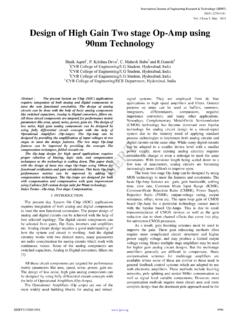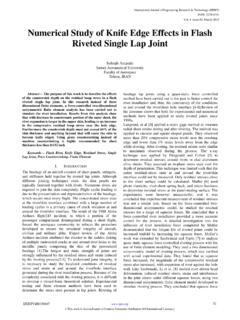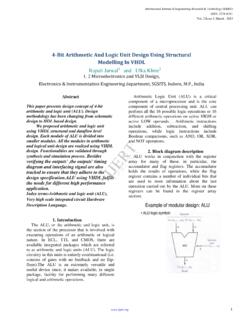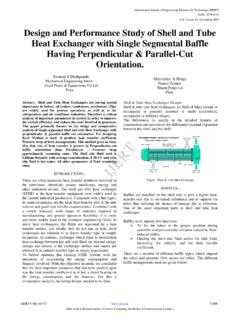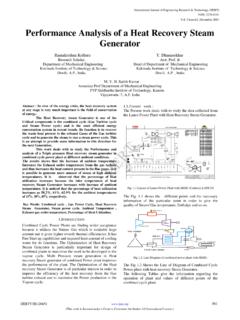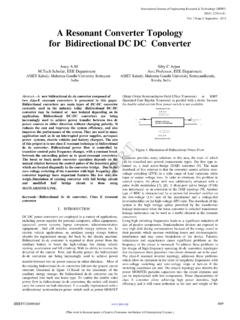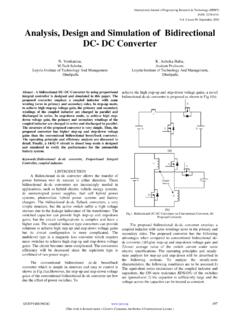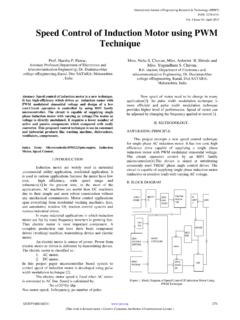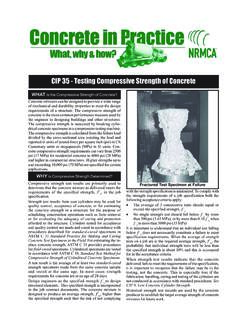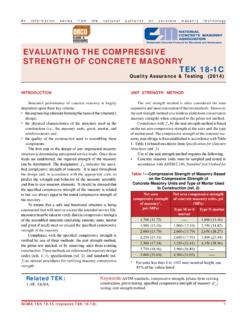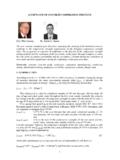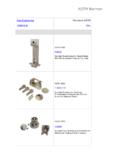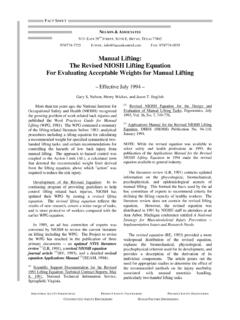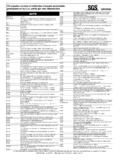Transcription of A Modified Bond Wrench Test for Evaluating Bond Strength ...
1 A Modified Bond Wrench Test for Evaluating Bond Strength of Concrete Repairs R. Radhakrishnan1, Syam and Prasad Varma Thampan. C. K3 1, of Engineering, Palakkad, Kerala, India 678 008, 2 College of Engineering, Thiruvananthapuram, Kerala, India, 695 016 Abstract Bond Wrench test is a widely used method to evaluate the quality of masonry work by determining the bond Strength between masonry unit and bedding mortar. This paper presents the details of an experimental investigation using the Modified bond Wrench test apparatus to evaluate the quality of concrete repairs by determining old-to-new (substrate-to-repair) concrete bond Strength . A Modified bond Wrench test set-up has been developed for this purpose.
2 Performance of three bonding agents were evaluated by this test. Bond Strength values of these specimens were determined also by splitting prism test and beam flexure test. A total of 83 specimens were subjected to various tests. Test results showed that good correlation exists between bond Strength values obtained by beam flexure test, splitting prism test and Modified bond Wrench test described in this paper. 1. Introduction In concrete repair applications, the bond between the old and new concrete usually provides a weak link in the repaired structure. The bond Strength mainly depends on adhesion in interface, friction, aggregate interlock and time dependent factors.
3 Each of these main factors in turn, depends on other variables. Adhesion to the interface depends on bonding agent, material compaction, cleanness and moisture content of repair surface, age of specimen and roughness of interface surface [1]. The most critical characteristics of the substrate surface are its roughness, cleanliness and moisture condition prior to application of repair material, and these are mainly dependent on workmanship. Workmanship plays an important role in good concrete repair and deserves an adequate attention. Also, inadequate substrate preparation is usually the main cause of bond failure in concrete repair [2].
4 Studies by Momayez showed that rough surface preparation leads to higher bond Strength (9- 25% increase) [1]. Sand blasting was the preparation method of the substrate surface that presented the highest values of bond Strength is shear and tension [3]. In the case of testing of adhesion of repair materials to a concrete substrate, coated with different bonding aids, the results obtained by different researchers are not always in agreement. Tests by Climaco et al. showed that good bond can be achieved by casting the repair against mature concrete with no bonding aids, provided the base surface is dry and reasonably roughened to an extent that the aggregate is exposed and no damage is caused to the concrete near the joint[4].
5 Also, due to the variability of the parameters that influence the bond Strength it is not possible to generalize or to extrapolate the conclusions drawn [5]. Following are some of the important observations reported by Julio from the available literature: Garbacz et al. state the increasing necessity of using a bond coat as the violence of the surface treatment increases [6]. Cleland and Long [7] concluded that the principal function of a bonding agent is to develop a bonding bridge between the repairing material and the concrete substrate. Talbot et al. [8] have stated that the use of bonding agent reduces the variability of bond Strength results. Tests indicated that increasing the compressive Strength of the added concrete relative to the compressive Strength of the substrate concrete improves the bond Strength and changes the rupture mode from adhesive to monolithic [9].
6 The addition of short carbon fibers at volume percentage resulted in mortars that bonded more strongly to old mortars. The increase in shear bond Strength was up to 89%. This effect is attributed to the lowering of drying shrinkage by the fiber addition. The effect is largest when the fibers were used with latex, which was in the amount of 20% of the cement weight [10]. In addition to the above factors, the measured bond Strength is highly dependent on the test method. Bond strengths of some tests were up to eight times larger than those obtained from others. Bond tests must be International Journal of Engineering Research & Technology (IJERT)Vol. 2 Issue 1, January- 2013 ISSN: selected such that they represent the state of stress the repaired structure is subjected to in the field.
7 The commonly used methods for evaluation of bond Strength between old and newly added concrete/repair material are slant shear test, pull-off tests, splitting prism and bi-surface shear test [1]. Good correlation between the slant shear test and pull-off test results were observed by Eduardo, et al [3]. The slant shear test appears to be a generally satisfactory method in terms of being representative of realistic stress states at the joint and also in regard to simplicity, reproducibility and sensitivity. It has been adopted in many standards but test procedures are not agreed and there are significant differences in specimen dimensions, shape, joint angles and surface preparations [4].
8 An abstract of various tests Evaluating bond Strength between concrete substrate and repair materials is given in Table 1(provided at the end of this paper). To compare and quantify the effects of various factors affecting bond in concrete repairs as described above, a simple bond test need to be devised. The concept of modifying the conventional bond Wrench was drawn from the fact that the bond between masonry blocks and bedding mortar has been found to be well evaluated by bond Wrench tests. This paper presents the details of an experimental investigation to extend the use of Bond Wrench , to evaluate the quality of concrete repairs by determining the bond Strength between concrete substrate and repair material under combined compressive stress and flexural tension.
9 The performance of three bonding agents were evaluated by determining bond Strength of repaired concrete specimens by Modified bond Wrench test, splitting tensile Strength test and beam flexure test. A total of 83 specimens were subjected to various tests. 2. Experimental Programme General The experimental study consisted of the following: (a) development of a bond Wrench test set-up to determine substrate-to-repair bond Strength (b) evaluation of the bond Strength performance of three bonding agents for repairing concrete specimens by bond Wrench test, splitting tensile Strength test and beam flexure test. (c) studying the correlation between the bond Strength values obtained from bond Wrench test, splitting tensile Strength and beam flexure test Materials used Cement used was Portland Pozzolana cement conforming to IS 1489 and the fine aggregate of zone II grading as per IS 383.
10 Coarse aggregate used was graded crushed granite aggregate of maximum mm size (IS 383-1970). Two bonding agents were selected based on the availability of products and reputation of the manufacturer. In addition, cement slurry, which is a conventional bonding agent, was also used. Thus, the bonding agents used for the study were: a) Cement Slurry of flow able consistency b) Styrene Butadiene Rubber (SBR) bonding agent (Solid content of 36%) c) Epoxy bonding agent (base : hardener parts by weight 100 :87) Bond Wrench test for concrete repair testing Fabrication of Modified bond Wrench The modification aimed at fabricating a bond Wrench test set-up for determining substrate-to-repair concrete bond Strength by following the principle of ASTM C 1072 test procedure used for conducting bond tests on masonry.

